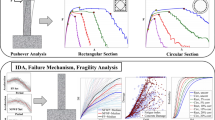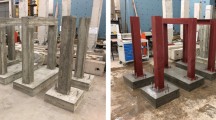Abstract
Structural health monitoring of existing bridges relies on vibration testing, but the free- and ambient-vibration testing techniques in current use for the determination of dynamic characteristics have a previously unknown dependency on vibration amplitude. The main purpose of this study is to investigate the dependency of the dynamic characteristics of reinforced concrete (RC) piers on the vibration amplitude in elastic and inelastic stages by applying free vibration tests to RC pier models. A series of free vibration measurements over a wide range of amplitudes were carried out with relatively small amplitude of excitation on intact models; these measurements were repeated after the models had been progressively tested to failure on a shaking table, and again after repair with carbon fiber sheets (CFS). The repair method used is one in common use for seismic repair of bridge piers: the damaged cross-section was recovered by wrapping carbon fiber sheets around the cross-section in the damaged zone, after injecting the relatively wide cracks with resin epoxy. Generally, our results indicate that overall natural frequency and damping ratio are very sensitive to the vibration amplitude level. Particularly, whenever the acceleration amplitude increases, the damping ratio significantly increases while the natural frequency slightly decreases; which means that, when considering the dynamic characteristics of a structure, we need to pay special attention to the expected vibration amplitudes before choosing design values. We also found that the CFS repair method was effective in restoring performance characteristics of the damaged piers.











Similar content being viewed by others
References
Celebi M, Phan LT, Marshall RD (1993) Dynamic characteristics of five buildings during strong and low-amplitude motions. Int J Struct Des Tall Build 2:1–15
Peeters B, Ventura CE (2003) Comparative study of modal analysis techniques for bridge dynamic characteristics. Mech Syst Signal Process 17(5):965–988
Takeshima R, Al Sehnawi R, Nakajima A, Nakamura S, Yokokawa H (2014) Study on change of vibration property of bridge structure with RC Pier in different vibration level. J Jpn Soc Civ Eng, Ser. A1 (Structural engineering and earthquake engineering (SE/EE)) (in printing)
Fukuwa N, Nishizaka R, Yagi S, Tanaka K, Tamura Y (1989) Field measurement of damping and natural frequency of an actual steel-framed building over a wide range of amplitudes. J Wind Eng Ind Aerodyn 59:325–347
Tamura Y, Suganuma S (1996) Evaluation of amplitude-dependent damping and natural frequency of buildings during strong winds. J Wind Eng Ind Aerodyn 59:115–130
Saito T, Nakajima A, Takeshima R, Al Sehnawi R (2013) Experimental investigation on vibrational property change of bridge model under various input level. J Struct Eng 59A:261–271 (in Japanese)
Egba Ernest I (2012) Detection of structural damage in building using changes in modal damping mechanism. IJEMS 3(3):250–255
G. Zafra R, Kawashima K, Sasaki T, Kajiwara K, Nakayama M (2013) Seismic performance of a full-scale polypropylene fiber reinforced cement composite bridge column based on E-Defense shake-table experiments. Proceedings of the international symposium for bridge earthquake engineering in honor of retirement of Professor Kazuhiko Kawashima, Tokyo, Japan
Kawashima K (2000) Seismic design and retrofit of bridges, 12WCEE
Ogata N, Maeda Y, Ando H (1994) Carbon fiber strengthening of existing bridges. 2nd US-Japan workshop on seismic retrofit of bridges, pp321–333, Report no. UCB/EERC 97-9, EERC, UCB, CA, USA
Priestley M.J.N, Seible F, Calvi G.M (1996) Seismic design and retrofit of bridges. TG300.P64 1996
Wakui H, Matsumoto N (1997) Seismic retrofit of railway bridges by means of carbon fiber. Civil Eng 82:10–12
Concrete Committee, JSCE (2007) Standard specifications for concrete structures (in Japanese)
Committee of structural engineering, JSCE (2000) Guidelines for bridge vibration monitoring (in Japanese)
Shoji G, Kitahara J, Kojima A, Kanakubo T, Shimizu K, Sakai Y (2008) Mechanism of seismic response of a PC cable-stayed bridge subjected to a long-period seismic excitation. Doboku Gakkai Ronbunshuu A 64(4):982–1001
Magalhães F, Caetano E, Cunha A, Flamand O, Grillaud G (2012) Ambient and free vibration tests of the Millau Viaduct. Evaluation of alternative processing strategies. Eng Struct 45:372–384
Vosooghi A, Saiidi MS (2013) Shake-table studies of repaired reinforced concrete bridge columns using carbon fiber-reinforced polymer fabrics. Struct J 110(1):105–114
Zhiguo S, Dongsheng W, Xiuli D, Bingjun S (2011) Rapid repair of severely earthquake-damaged bridge piers with flexural-shear failure mode. Earthq Eng Eng Vib 10(4):553–567
Walker R, Karbhari VM (2006) Durability based design of FRP jackets for seismic retrofit. COMPOSITE 2006 convention and trade show. American Composites Manufacturers Association, Arlington
Lee DH, Park J, Lee K, Kim BH (2011) Nonlinear seismic assessment for the post-repair response of RC bridge piers. Sci Direct, Compos: part B 42:1318–1329
Acknowledgments
The authors are grateful to Structural Laboratory members of Architecture and Civil Engineering Department at Utsunomiya University, especially Dr. Y. Suzuki, for their help during the preparation of specimens. Also we are grateful to Mr. A. Kobayashi of Composites Company, Nippon Steel and Sumikin Materials Co., Ltd for providing carbon fiber sheets materials.
Author information
Authors and Affiliations
Corresponding author
Rights and permissions
About this article
Cite this article
Al Sehnawi, R., Nakajima, A., Takeshima, R. et al. Experimental investigation of amplitude dependency of dynamic characteristics in elastic and inelastic stages of reinforced concrete pier model. J Civil Struct Health Monit 4, 289–301 (2014). https://doi.org/10.1007/s13349-014-0092-5
Received:
Accepted:
Published:
Issue Date:
DOI: https://doi.org/10.1007/s13349-014-0092-5




